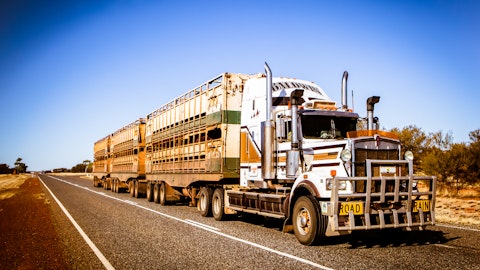Jason Seidl: Fair enough.
Doug Col: You know, Jason, and just to follow up on that. I mean, I think if you were able to go forward and look back in a few years and say, where did all the growth come from? I still think our biggest opportunity is in markets that we already say we have a presence, but we don’t have a representative footprint to provide the same level of coverage as some of our peers. When I think of some of our legacy markets, if I think go down to our Gulf States routes and think about Louisiana and across through Texas. I mean, we have much higher market share there in terms of revenue share than we do in other parts of the country. So if I look at Texas, for example, we’ve got probably close to a couple of dozen terminals down there.
We’ve got a representative footprint that matches some of our national peers. We’ve got a double-digit revenue share there. And you compare that to our headline share in the industry, and we’re a 5% or 6% share of revenue. But in a market where we’ve got a similar footprint, our service allows us to go take share. So if we go do that in the Northeast, we’ve gone from zero there to something like probably 3% to 3.5% share these days in a matter of a few years. But there’s several regions in the country where we just need to be closer to the customer. We say, we cover the market, but if we had two or three more terminals, we can get share. So, it’s an exciting time, and we look forward to getting a more representative footprint and taking that share.
Jason Seidl: Well, Doug, in terms of taking more share, getting back to the hires that you had in the quarter, I mean if 40% were drivers, I mean, 60% were potentially out there that could be salespeople. So did you have a lot of sales hire in the quarter that could sort of ramp up and sort of give you some of that density that you’re looking for in some of those areas?
Fritz Holzgrefe: We certainly added a complement of sales folks as well in the quarter. It’s great to be in a position where you’ve got – you can attract salespeople, because they’ve got a great product to sell. So that’s been good. That built and we’ve been able to add salespeople and not only developing markets, but ones that we’ve been in for a while. So it’s a good place to be.
Jason Seidl: Appreciate the color, guys and the time.
Fritz Holzgrefe: Thanks Jason.
Operator: Thanks. Your next question comes from the line of Tom Wadewitz with UBS. Please go ahead.
Tom Wadewitz: Yes, good morning. So, I wanted to ask you a quick one on price, and then I have a question on the terminals as well. How should we think about revenue per underweight ex fuel a pretty strong number 8.4% in the quarter? Is that something that can build further as you reprice more of the book? Or is that kind of a good run rate that we should look at going forward?
Fritz Holzgrefe: Yes. I mean, the yield calc itself, like you know, is influenced a little bit by the weight per shipment decline we saw. But I think – I mean, our revenue per shipment growth was still positive at 3% ex fuel with a 7.5% announced GRI, and with growth in some of our national account customers that may not be operating as well with these new volumes, we’re going to push for at least that. Our contractual renewals in the quarter were 5.6%. And that stuff that was really started leading up to the disruption in the industry. So they don’t really even reflect the tightness that’s going on post that event. So, I mean, that rate was higher as we exited Q3 than the headline, 5.6%. So our recent renewals are running higher than that. We continue to think there’s an opportunity to raise rates and the yield will be influenced a little bit by where the weight goes from here.
Tom Wadewitz: Yes. Okay. All right. And then I wanted to ask you kind of related to the growth in the terminal network. How we should think about your approach with the Yellow terminals. I guess it’s kind of twofold. One would be how do you think we should measure success? So the results come out, you issue an 8-K. If you get more terminals, is that a good thing? I would tend to think, so, I don’t know if it’s like, hey, you get five, that’s kind of not as good, you get 30 terminals, that’s great. So, I guess just kind of high level, how might we think about whether you’re successful or not with the Yellow terminal bid process. And then, I guess related to that, it does seem like you have a real opportunity to pull forward some of that or build the pipeline in future growth.
And I think the market’s got a lot of confidence, notwithstanding some noise today in your ability to execute. So can you think about, hey, we’ll just really pull forward and will kind of load up on future growth because we have the strategic opportunity to add a lot more terminals as opposed to doing kind of year-by-year?
Fritz Holzgrefe: Yes. So Tom, the way I would think about this is a little bit how we’ve been thinking about it ongoing is that we are continuously looking at our pipeline of opportunities, which extends out for a couple of years. And we’re very judicious about identifying locations where they need to be, what the profile of those facilities are, where our customers and making sure the facilities that we had are there. I think our – if you look back at our track record, we know how to open things organically. We know how to build facilities and open them and do that in a pretty value-adding way. As far as what is going on with in the Yellow process, I mean, I think that those are all facilities that are in some form are going to be available to the market, right?
So, we consider anything that’s out there that those are facilities that we look at and our position in the market are ones that we take it – we’re not – we’re buying facilities from the companies that are much larger than we are in our space. So, if the available assets are there, and we have the opportunity to participate in those or as others maybe pursue opportunities and need to vacate a facility, those are things that we do pretty successfully. So this – I don’t have a measurement around how many we need to have at any given point in time. I have a measurement that says, we think we probably need to get to 240 to 250 facilities to provide apples-to-apples coverage and service to best-in-class. And I think we build to that point. We’ll do it in a way that’s judicious over time in which we are not only creating value for our shareholders but also for our customers.
So it’s still a multiyear process, however you think about it.
Tom Wadewitz: Just one follow-up on that. Do you consider a bigger step up? Is that something that could make sense? Or you want to keep it more smooth?





